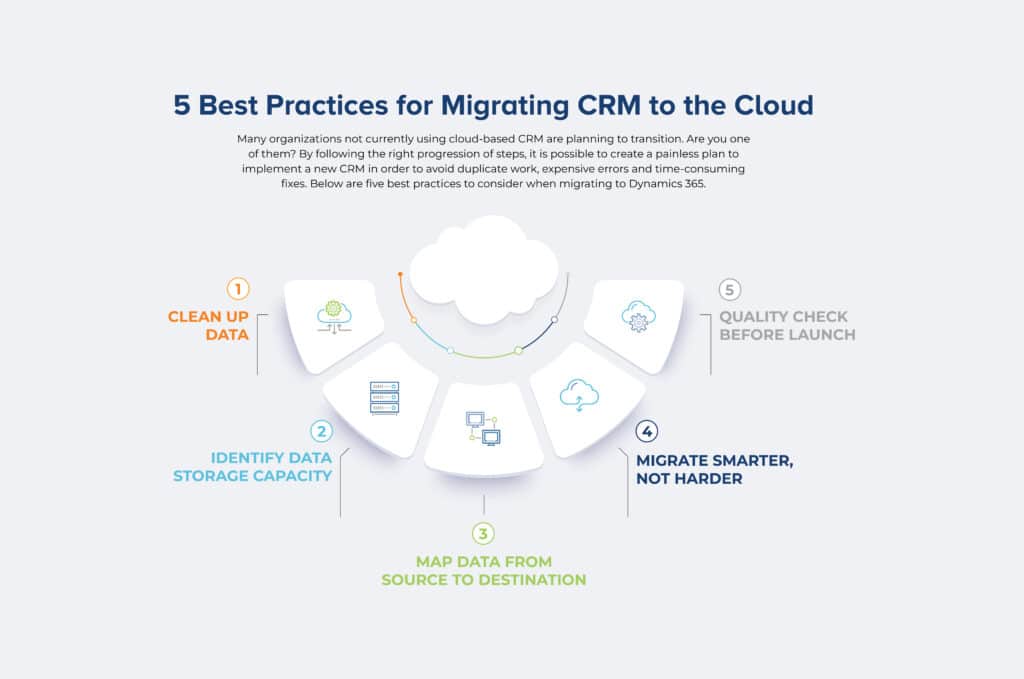5 Best Practices for Microsoft Dynamics 365 Data Migration
Discover essential best practices for data migration in Dynamics 365. Ensure a seamless transition and optimize your data management strategies effectively.
Table of Content
According to the Flexera 2020 State of the Cloud Report, enterprises are continuing to invest in multiple cloud platforms, with 93% of the 750 respondents implementing either a multi-cloud or hybrid cloud strategy. And due to the global pandemic, more than 50% of a subset of 187 survey respondents report actual cloud usage as higher than initially planned.
Within this environment, Microsoft’s customer relationship management (CRM) system Dynamics 365 is becoming the most popular Software as a Service (SaaS) platform in the marketplace. Organizations use Dynamics 365 to store all data crucial for developing, improving and retaining customer relationships. With a module-based system, Microsoft Dynamics 365 also offers support for other aspects of a business, like enterprise resource planning (ERP) and project management. If you see technical advances in your company’s future, migrating to Dynamics 365 for your CRM is a smart move.
Given these recent trends, many organizations not currently using cloud-based CRM are planning to transition. Are you one of them? The process can be a smooth one, but it takes some preparation. By following the right progression of steps, you can avoid duplicate work, expensive errors and time-consuming fixes. Follow these five tips for creating a painless plan to implement your new CRM.
Look at this transition as an opportunity to sift through data from the various sources they live — such as Excel, existing CRM solutions, and Access — before moving to the new system. Remove or redistribute duplicate records to create new storage space. Ensuring data integrity saves expense from inaccuracies post-migration and allows a data re-set for your new CRM. It also eliminates the time and effort it would take to send the duplicate or unneeded records to the new system. This step will take time, but a thorough data cleanse is worth the investment.
After scrubbing your organization’s existing data pool, determine exactly what information will move to the new system. Then, establish the necessary storage scope for migration to be successful. Exceeding storage capacity is one of the greatest setbacks an enterprise can encounter during the CRM transition. Calculating necessary bandwidth pre-migration also saves organizations money in the long run. A tighter scope means less data, reduced CRM storage, and fewer costs.
Determine which origin fields will match which destination fields and how these fields will look after migration. Analyze the contents of legacy fields and identify any that are rarely used. If these fields are not needed in the new system, it may not make sense to migrate data from them. Otherwise, consider how the new CRM’s functionality can improve their use.
Migration can happen more efficiently when enterprises consider a few critical smart practices while moving to the new system. First, document any changes to existing workflows. Next, back up original servers before migration in case any pertinent data is lost in transition. Finally, mirror the CRM data architecture to maintain its hierarchy and eliminate duplicate data that slips past inspection.
Enlist the help of end users to verify migration before launch. Check for any missing data, confirm that on-premises and cloud fields match, and ensure workflow functionality. This pilot test takes place in the user acceptance testing (UAT) environment; enterprises can determine if the migration is meeting system requirements and catch any inaccuracies or errors before the go-live date.

If you’re bringing your CRM system to the cloud, our Dynamics 365 for operations data migration can make it happen quickly and reliably. At Velosio, we make migrating to Dynamics 365 simple with a trusted team of professionals on hand.
Talk to us about how Velosio can help you realize business value faster with end-to-end solutions and cloud services.